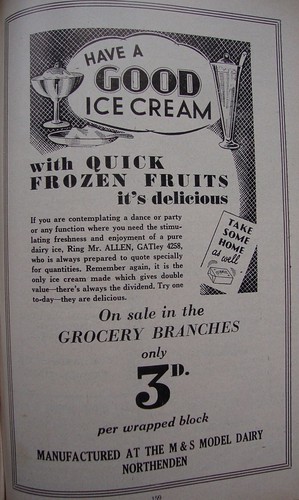
Having a few items in the freezer is taken for granted. But back in the 1950's it was a novelty for Britain. Most people then didn't have a refrigerator with its small compartment for frozen food. Just keeping butter and milk cool in summer was down to having a decent larder or a piece of furniture in the kitchen called a meat safe.
The picture is from 1950 and shews the Co-op employee at the Great Western Street branch talking up the merits of frozen food to the busy housewife. Note the chest freezer with whatever is inside buried in the dark. The selling point then and now has always been economy & convenience - there is no waste, and you don't have to wash and peel the vegetables - the birth of the ready meal. The M and S Co-op could announce "no less than 44 of our grocery branches now have a refrigerator which carries a stock of fruit, vegetables, or frozen fish fillets. Why not give yourself a treat and try the new flavour of quick-frozen foods?"

We all have to thank Clarence Birdseye with lots of help from his wife Eleanor for this. Their experiments in the kitchen to bring the winter of Labrador to the summer of New England by mechanical means gave the world quick-frozen food. That was back in the early 1920's. It took years and millions of dollars of development before it arrived into small grocery stores. Now you take it for granted. However you have to have a whole separate logistics of warehousing, transporting, and retail cabinets to move food at minus 21 degrees celsius from the factory to the home.
Home refridgerators with their tiny icebox were still an expensive purchase for those on workers wages. So the ice cream would have to eaten within an hour or so of purchase.
I would recommend reading the development of Birds Eye in the UK from 1946 to become market leader if you want to know more about the frozen food industry.
www.blackwellpublishing.com/grant/docs/13BirdsEye.pdf
2 comments:
Yes it is amazing to think what the fridge has done to our lifestyles. On Beech Road in 1911 of the 23 shops, 13 were engaged in selling food. And there were more around the green and lots more just the short walk up to and along Barlow Moor Road.
Now in an age before refrigerators this shouldn’t surprise us. People shopped daily because they had to, and if they didn’t make the journey themselves then a servant would or equally likely the shop delivered. Look at any old photograph of Chorlton and somewhere on the road there will be one or more delivery vans, pulled by horses.
One of life's conundrums. You want stuff fresh and you want it to keep days. Thankfully the fridge did put an end to "Sterilised Milk". It kept without being chilled and was nothing like real milk.
Post a Comment